Key takeaways:
- Participant feedback is essential for improving workshops, providing insights on audience engagement and knowledge gaps.
- Utilizing technology, such as live polling and digital whiteboards, enhances feedback collection and fosters a more engaging environment.
- Creating a comfortable and open atmosphere encourages honest dialogue, allowing deeper participant connections and richer feedback.
- Acting on feedback and following up with participants demonstrates their contributions are valued, transforming the workshop experience.
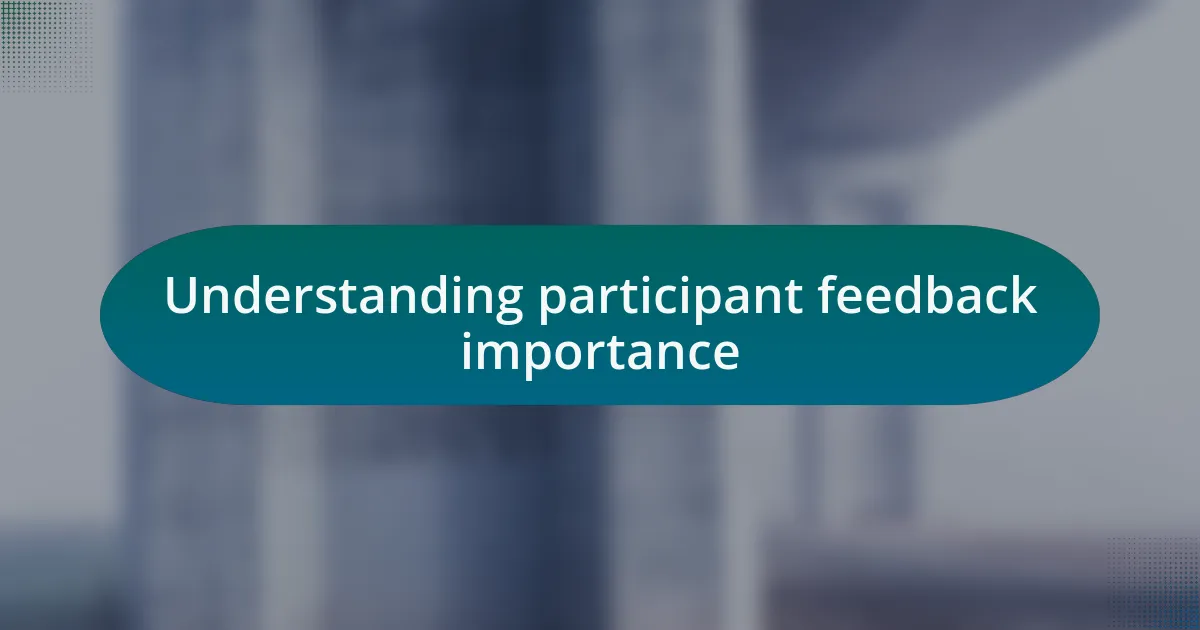
Understanding participant feedback importance
Participant feedback is crucial because it serves as a mirror reflecting the true experience of attendees. I remember one workshop I facilitated where I underestimated the importance of gathering feedback. After receiving candid comments, I realized that some topics weren’t resonating with my audience as I had anticipated. This revelation changed my perspective on planning future sessions.
When I think about feedback, I often wonder: what if we never sought it out? I’ve seen firsthand how feedback can highlight gaps in knowledge or engagement that I might miss while presenting. The insights from participants have often led me to adjust my approach, crafting a more tailored and impactful experience for everyone involved.
Moreover, consider the emotional aspect of feedback; it creates a sense of community. When attendees know their voices matter, it fosters a collaborative environment. I recall a workshop where an attendee shared a profound personal story related to the topic. Their openness encouraged others to chime in, enriching the discussion and reinforcing the collective experience. This is why prioritizing feedback is not just a formality—it’s essential for growth and connection.
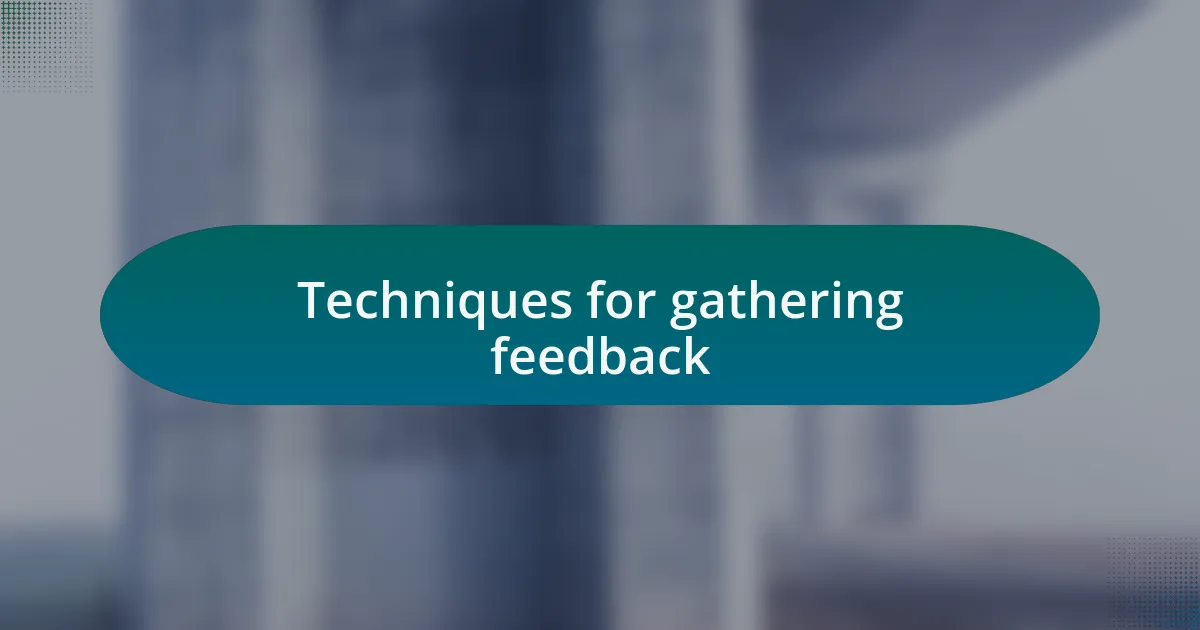
Techniques for gathering feedback
One effective technique I’ve found for gathering feedback is to incorporate real-time polling during workshops. For instance, in a recent session, I utilized an interactive app that allowed participants to vote on topics or rate their understanding of concepts as we progressed. The immediate nature of this feedback felt exhilarating for both me and the attendees, revealing areas where I could dive deeper, and ensuring everyone stayed engaged.
Another approach I often adopt is the use of post-workshop surveys. I prefer to keep these surveys short and focused, which increases the likelihood of responses. After a particularly intensive workshop, I specified just three key questions, allowing participants to express what they loved and what they felt could be improved. I distinctly remember receiving comments that helped me identify a previously overlooked aspect of my presentation style—an invaluable insight that reshaped my subsequent workshops for the better.
I also encourage open discussions at the end of each session, giving participants a platform to share their thoughts verbally. One time, a participant expressed concern over a technical concept I had presented, prompting a lively debate that revealed misconceptions shared by others. This interaction not only validated their feelings but also highlighted the collective need for clarification. Isn’t it fascinating how a single conversation can reveal a wealth of feedback that can enhance the learning experience for everyone involved?
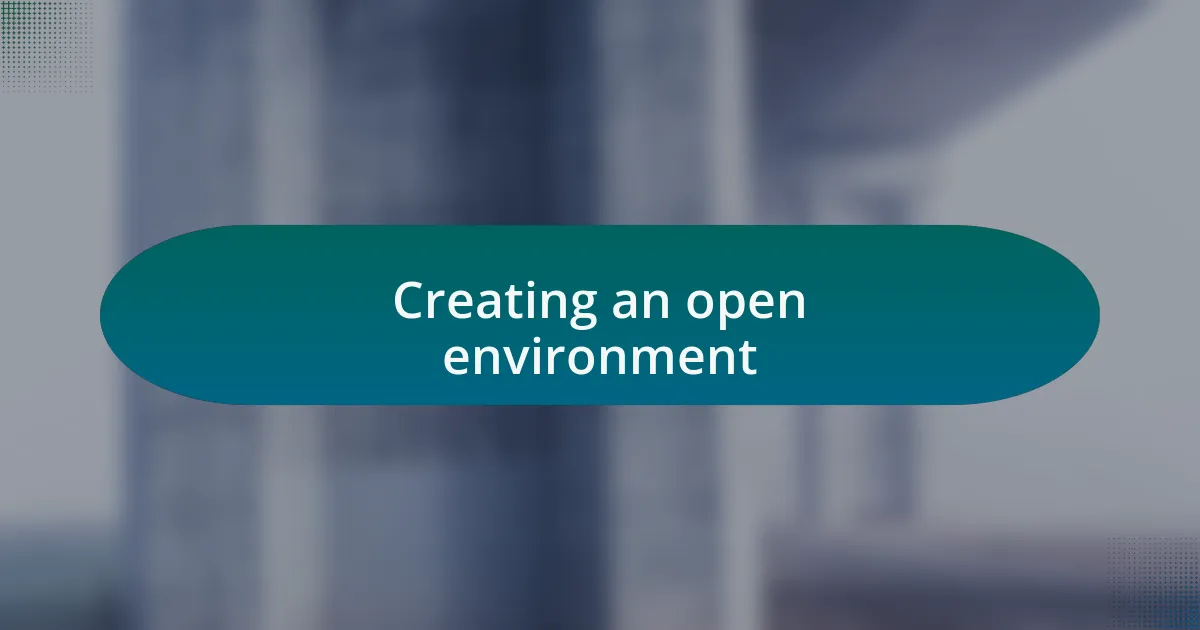
Creating an open environment
Creating a truly open environment during workshops is essential for fostering participant feedback. I remember one workshop where I began by sharing a personal story related to the topic. This vulnerability encouraged participants to open up, knowing they could share their own experiences without judgment. I often ask myself, how can I make everyone feel this level of comfort? The answer lies in being relatable and approachable, creating an atmosphere where feedback flows naturally.
It’s also crucial to actively listen when participants do share their thoughts. In a recent workshop, one attendee mentioned feeling overwhelmed by the pace of the session. Instead of brushing it off, I paused and asked how I could adjust my delivery. Surprisingly, several others echoed similar sentiments. This moment became a catalyst for a discussion that reshaped our remaining time together. It’s moments like these that make me realize how valuable participant insights are to enhancing the workshop’s effectiveness.
Moreover, I like to incorporate small group discussions to empower individual voices. During a tech workshop, I formed breakout groups where participants could brainstorm solutions to a challenge we were discussing. The atmosphere was electric! I remember getting a follow-up email from one participant who shared how that brief, intimate setting allowed her to express opinions she felt were lost in a larger group. Isn’t it incredible how a simple shift in format can facilitate deeper connections and richer feedback?
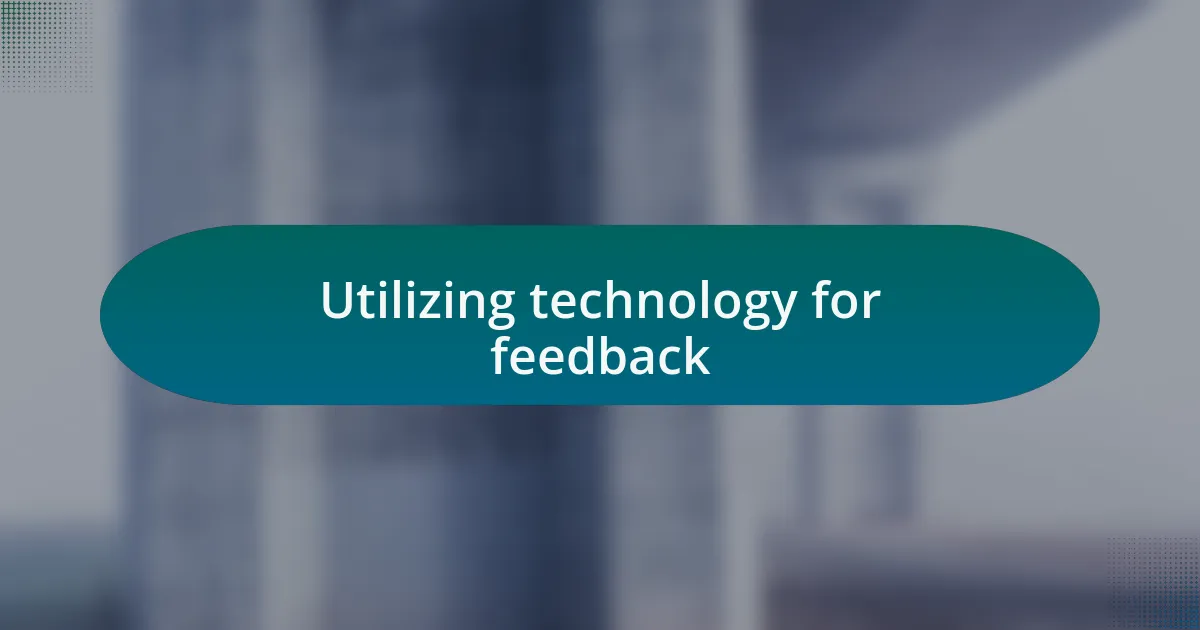
Utilizing technology for feedback
Utilizing technology for feedback can transform the way we gather insights during workshops. I’ve started using live polling tools like Slido or Mentimeter, where participants can submit their thoughts and questions in real time. This not only makes everyone feel included but also provides a visual representation of opinions that can foster deeper discussions. I often surprise myself with the level of engagement that arises from those instant polls. Isn’t it fascinating how technology can bridge communication gaps?
In a recent session, I applied a digital whiteboard, giving everyone a space to anonymously jot down their feedback throughout the workshop. Participants seemed more inclined to share their thoughts freely, without any pressure. There was a moment when someone highlighted a specific topic that resonated deeply with them, sparking a lively conversation. That unexpected pivot in discussion felt electric, and it dawned on me how crucial anonymity can be in allowing authentic feedback.
Another effective method I’ve discovered is the use of feedback forms sent through QR codes. It’s incredibly simple; I place a code on the last slide of my presentation, encouraging participants to scan it and share their opinions immediately. In doing so, I’ve noticed that people reflect on their experiences right after the session, resulting in more genuine insights. Don’t you think the ease of technology can seriously enhance that critical feedback loop?
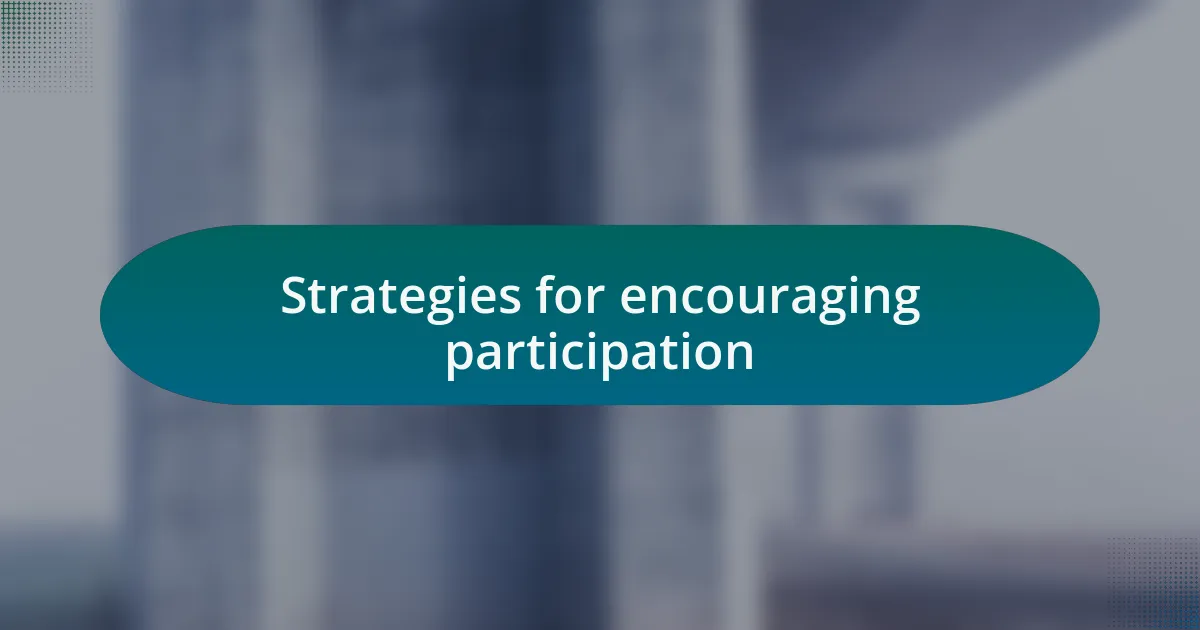
Strategies for encouraging participation
One strategy I’ve found effective in encouraging participation during workshops is creating breakout sessions. These smaller discussions allow participants to express their thoughts in a more intimate setting. I remember a workshop where I divided the group into pairs to brainstorm ideas on a new tech concept. The buzz of conversation in those small groups was electric, and I could see how much more comfortable everyone felt sharing their insights. Isn’t it interesting how a bit of reduced pressure can lead to more honest dialogue?
Incorporating gamification elements into feedback can also significantly enhance engagement. I once used a point system where participants earned points for sharing their ideas or answering questions. The competitive spirit it sparked was remarkable; people were eager to contribute, and the energy in the room heightened. Reflecting on that experience, I realized that turning feedback into a game not only makes it enjoyable but can also uncover insights that might otherwise be hidden. Have you ever noticed how a little fun can completely transform the mood of a workshop?
Lastly, I’ve learned the value of follow-up engagement. After a workshop, I make it a point to send a personalized thank you note that highlights some of the key feedback shared. This acknowledgment shows participants that their contributions matter and encourages them to continue the conversation. When I see their responses come pouring in, I know I’ve created an ongoing dialogue that extends beyond the event itself. Isn’t it rewarding to feel like everyone’s voice is part of a larger community?
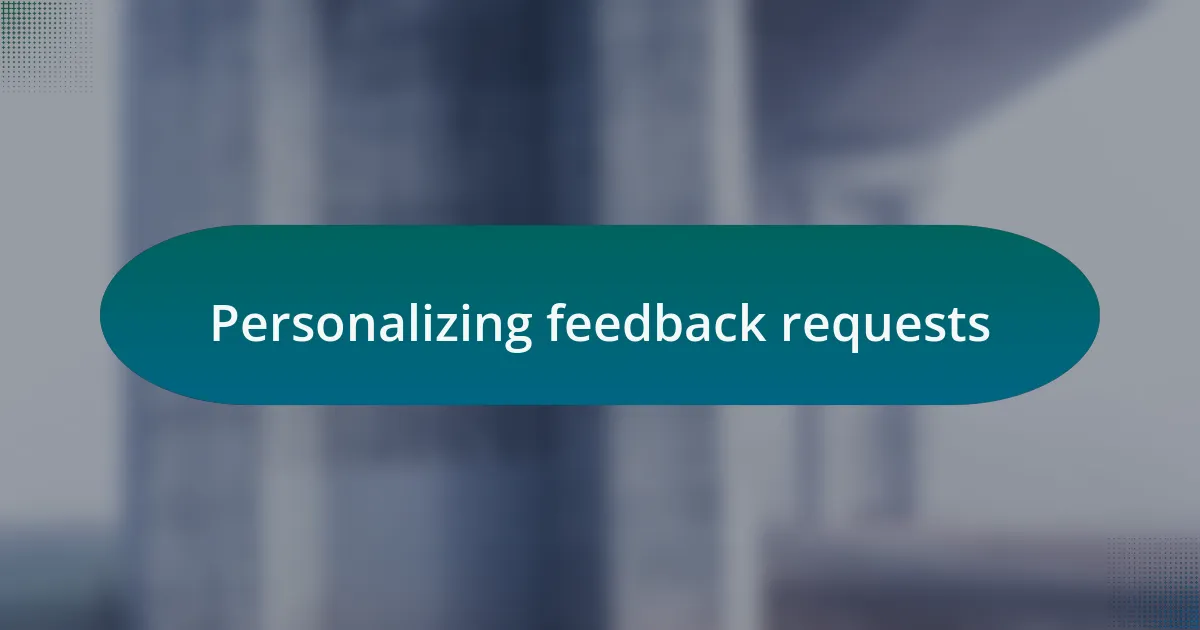
Personalizing feedback requests
Personalizing feedback requests begins with knowing your audience. For instance, I once tailored my feedback forms by incorporating specific questions related to the attendees’ backgrounds and interests in tech. This not only made them feel valued but also provided me with deeper insights into their unique perspectives. Have you ever seen how a personal touch can prompt more thoughtful responses?
I also make it a point to reference individual contributions during discussions. When I seek feedback, I’ll mention a participant’s earlier point and ask for their thoughts on it specifically. This practice fosters a sense of importance and connection, showing that their input is not just heard but genuinely considered. I still recall how one attendee lit up when I acknowledged their suggestion on integrating AI tools—a moment that highlighted the collective expertise in the room.
Additionally, I’ve found that framing feedback requests in a personal way can create a more compelling invitation for participants. Instead of generic prompts, I craft requests that resonate with their experiences. I once sent a tailored survey after a workshop on cybersecurity, asking attendees how they felt about the practical applications of the concepts discussed. The responses were richer and more detailed because participants recognized that I was genuinely interested in their views. Isn’t it amazing how a little personalization can transform a simple request into a meaningful conversation?
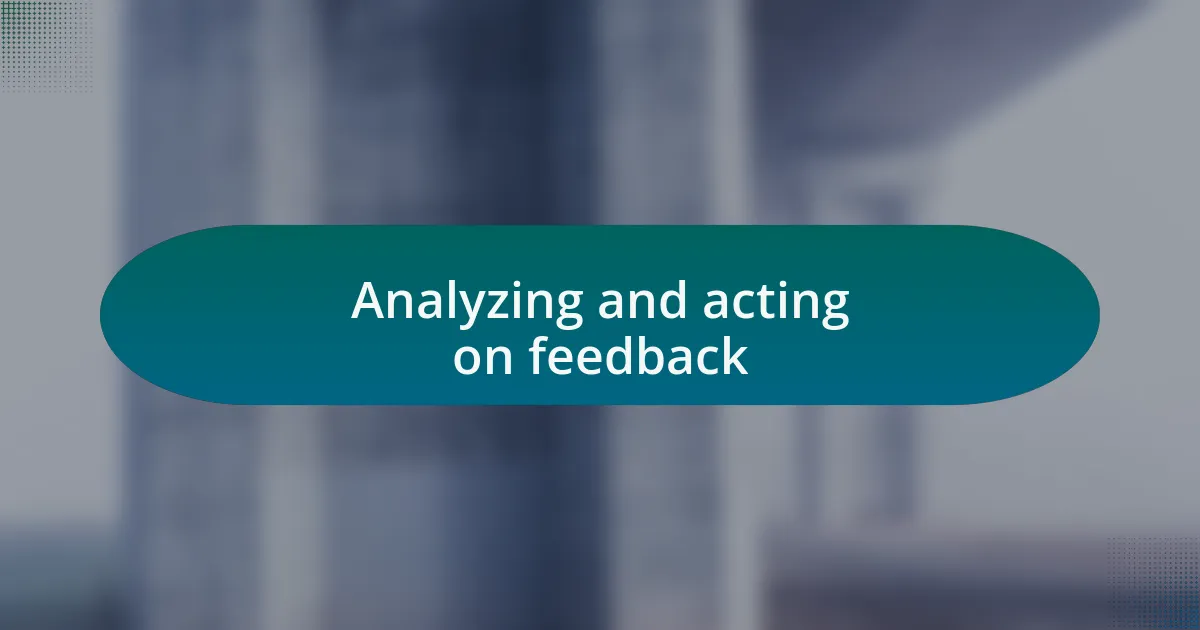
Analyzing and acting on feedback
When analyzing feedback, I’ve learned to look beyond the surface responses. During a recent workshop, I took note of not only the ratings but also the comments that attendees left. One participant mentioned feeling overwhelmed by the pace of the presentation. I was struck by this insight—it highlighted an area I hadn’t considered fully. Have you ever had a moment where a single comment opened up new perspectives for you?
Acting on feedback is where the real magic happens; it’s not just about collecting data but transforming it into action. I vividly remember implementing changes after receiving input on our session structure. By slowing down and incorporating more interactive elements based on attendees’ suggestions, I noticed a notable improvement in engagement levels in subsequent workshops. Isn’t it exhilarating to see direct results from listening?
Moreover, I make it a priority to follow up after implementing changes. After I adjusted a workshop based on previous feedback, I reached out to inform attendees of the modifications. Their appreciative responses felt rewarding, confirming that they valued being part of the process. How often do we consider the importance of continued dialogue after initial feedback? It transforms participants from passive listeners to active contributors in future events.